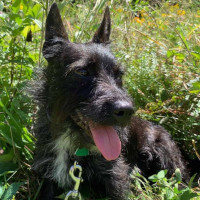Appearance of the Scobo Terrier
|
| The Scobo Terrier is a small dog. When fully grown, they weigh no more than 11.5 kilos. They have short, compact legs. Their body is small but stocky. His dark eyes may appear exorbited, like those of the Boston Terrier's parent breed. His ears are likely to be erect. He is likely to be dark in color - either black all over, black with brown markings, brown or brindle. He may have a few white markings on his face, although this is rare. The texture of his coat, however, is another story. Depending on the breed of the dominant parent, his coat may be short and straight, or longer and rougher. It can also have what looks like a beard, like the parent Scottie breed. Of course, it all depends on genetics. |
Temperament of the Scobo Terrier
|
| The Scobo Terrier is a gentle, affectionate dog. They are highly intelligent and can even be a little mischievous at times. His antics will keep you entertained at all times. They never meet strangers. He may bark and try to look aggressive if visitors come to the door; however, he's more likely to greet them warmly as soon as they enter. He's great with children and all other family members. In fact, he can be very protective of children. He's very easy to train, but persistence is the key. When you get him used to the house, take him out at the same time every day. Soon, he'll know what you expect of him. He's very eager to please, which makes his training easier. He can be prone to separation anxiety, so the Scobo Terrier may not be suitable for those who are often away from home. Again, he's a good watchdog - he'll certainly alert you to any trouble on his territory - but he's more likely to befriend a stranger than scare off a potential intruder. |
Needs and activities of the Scobo Terrier
|
| The Scobo Terrier is not a dog that needs a lot of activity to stay happy. However, to keep him healthy, you must allow him to have several short periods of activity during the day. Don't forget that giving him these opportunities to be active prevents him from getting bored. When bored, Scobo Terriers often become destructive, chewing on shoes and other valuables. He'll also enjoy outings to the dog park and, once perfectly trained, will have no problem getting off the leash and back on your command. He'll also enjoy playing outdoors, under your supervision. Don't forget that the Boston Terrier's parent breed often suffers from brachycephalic syndrome. If you allow him to overheat or overexert himself, your Scobo Terrier could suffer serious health consequences. Keep water handy if you go out on hot days, and give him time to rest if necessary. |
Maintenance of the Scobo Terrier
|
| The Scobo Terrier will probably require little maintenance, whatever coat type he inherits. Brush him once a week to remove excess hair. He's likely to shed more in spring and autumn. At these times of year, brush him two or three times a week to prevent excess hair from accumulating on your clothes and furniture. Only bathe him when necessary. The natural oils in his coat will keep him shiny and clean. Brush his teeth two or three times a week to prevent tartar build-up and bad breath. To prevent tooth decay, brush his teeth every day. Trim his nails every two or three weeks, provided he doesn't wear them down naturally. As a general rule, if you hear his nails clicking on the tiles, it's time to trim them. |









 English (United Kingdom)
English (United Kingdom)